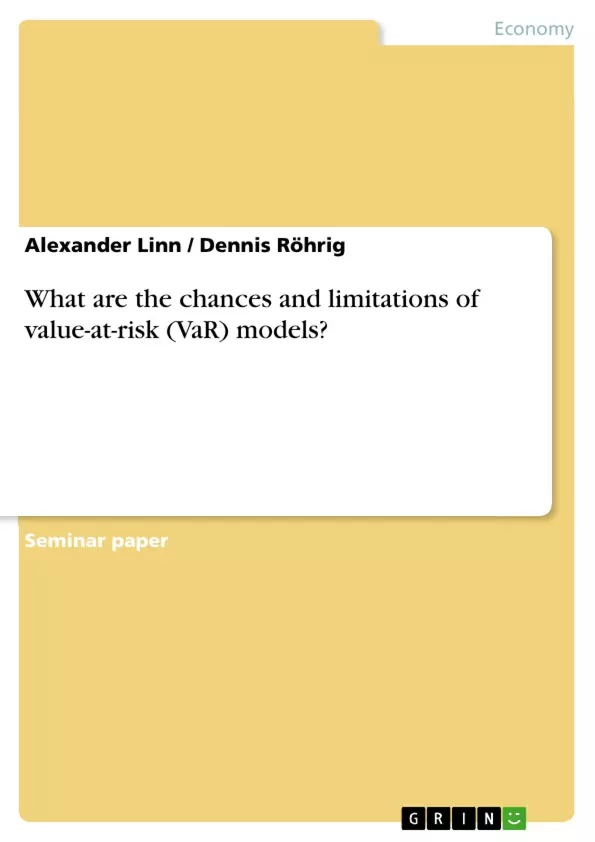The risk and return framework is generally accepted and discussed by scientists, at least since Markowitz introduced his Portfolio Theory in 1952. Subsequently, models were developed to evaluate investments under consideration of risk and return. Traditionally, practitioners primarily focused on past earnings as a measure of the profitability of an investment, without adequately considering potential risks. Therefore, the development of professional risk management systems was often neglected. Thus, the possibility of high losses was not appropriately incorporated in their investment strategies.
The consequences of such mistreatment became evident in the mid 1990s, when some of the world’s largest companies faced huge losses and sometimes even insolvency. Most of these failures were a direct result of inappropriate use of financial instruments and insufficient internal control mechanisms. The most spectacular debacles even resulted in losses of more than one billion dollars for each affected institution.
In case of Barings Bank, a single trader ruined the 233-year old British financial institution by inappropriate investments in high-risk futures in 1995. The consequent loss of $1.3 billion, realized in a very short period, could not be absorbed and forced the downfall of Barings. At Daiwa Bank, it was also a single trader who caused a $1.1 billion deficit. In contrast, the losses were accumulated over 11 years from 1984. Another well-publicized bankruptcy was declared in 1994 by the Californian Orange County, after losses of $1.8 billion. Such evidence of poor risk management and control shows that proper financial risk management is crucial for all kinds of institutions in order to guarantee stability and continuity.
Therefore, it is necessary to establish adequate risk management processes and to develop appropriate tools, which quantify risk exposures of both entire institutions and single financial instruments. This risk quantification should alert management early enough to prevent exceptional losses. One of the key concepts addressing these prob-lems of modern risk management was introduced in 1993 with the Value-at-Risk (VaR) models.
Inhaltsverzeichnis (Table of Contents)
- Introduction.
- Purpose of the Study.
- Methodology
- Calculation of VaR.
- Risk Management Framework.
- VaR Concept.
- Calculation Methods.
- Historical Method.
- Monte Carlo Simulation Method.
- Analytical Method.
- Adaptation of the Principle Methods
- Weighting of Past Observations
- Backtesting
- Scenario Analysis and Stress Testing.
- Extreme Value Theory.
- Evaluation of VaR.
- Method Comparison
- Chances of VaR
- Practicability as a Risk Measure.
- Realistic View of Risk.
- Effective Risk Monitoring.
- Flexibility of VaR models.
- Support by Regulatory Body.
- Limitations of VaR
- Confidence Interval.
- Comparability of Results.
- Sub-additivity.
- Historical Data.
- Application Difficulties.
- Estimation Error and Fat-Tails.
- Estimation Bias and Manipulation.
- Conclusions.
Zielsetzung und Themenschwerpunkte (Objectives and Key Themes)
This seminar paper aims to examine the potential and limitations of value-at-risk (VaR) models in risk management. The authors delve into the concept of VaR, its calculation methods, and its practical applications. They also explore the advantages and disadvantages of employing VaR models as a risk management tool.
- Concept and Calculation of VaR
- Evaluation of VaR models' strengths and weaknesses
- Practical applications and limitations of VaR models
- Comparison of different VaR methodologies
- Impact of regulatory frameworks on VaR model usage
Zusammenfassung der Kapitel (Chapter Summaries)
The paper begins with an introduction outlining the purpose and methodology of the study. The second chapter dives into the calculation of VaR, exploring its underlying framework, concept, and various calculation methods, including the historical method, Monte Carlo simulation method, and analytical method. This section also discusses adaptations of these methods, such as weighting of past observations, backtesting, scenario analysis, and extreme value theory.
Chapter three focuses on evaluating VaR, examining its benefits and limitations. This includes comparing different VaR methodologies and highlighting the advantages of VaR models such as their practicality, ability to provide a realistic view of risk, and effectiveness in monitoring risk. The chapter also delves into the limitations of VaR, such as the confidence interval, comparability of results, sub-additivity, dependence on historical data, application difficulties, estimation errors, and potential for manipulation.
Schlüsselwörter (Keywords)
The paper explores the key concepts of value-at-risk (VaR) models, risk management, risk measurement, historical method, Monte Carlo simulation, analytical method, confidence interval, sub-additivity, estimation error, and backtesting. It delves into the practical implications of VaR models in the context of regulatory frameworks and industry practices.
- Quote paper
- Alexander Linn (Author), Dennis Röhrig (Author), 2004, What are the chances and limitations of value-at-risk (VaR) models?, Munich, GRIN Verlag, https://www.grin.com/document/55350



